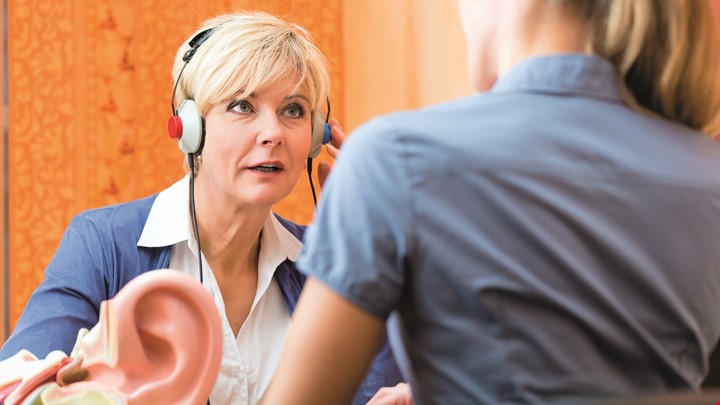Hearing test: Procedure and result
30 minutes for your hearing
This is how we hear
Hearing impairments usually occur gradually. If the cases of non-understanding accumulate, the cause should be identified. Upon request, the hearing care professionals at KIND can perform a wide range of hearing tests. This is what a hearing test procedure looks like.

How well do I actually hear?
"What did you say?", "Sorry, I didn't understand you just now", "Please close the window, you can't understand a single word!" - Anyone who frequently encounters situations in which spoken words are not clearly heard should check their hearing ability. However, this can only provide an initial assessment. If there are indications of a hearing impairment, a comprehensive, professionally conducted hearing test is indicated. This can be carried out in all KIND branches. It usually takes 30 minutes, followed by an explanation of the results.
From quiet to loud
The hearing test begins with a short conversation in which the hearing care professional asks questions about the client's hearing reality. In addition to a few personal details, he also asks about hearing situations that the client would like to improve, such as conversations in larger groups or when going to the cinema or theatre. The first step in the hearing test procedure is an otoscopy, i.e. a look inside and behind the ears. This gives the hearing care professional an impression of the condition of the external auditory canal and looks to see if there are any scars that might indicate a previous operation.
The first step in the actual hearing test procedure is a sound audiometry: the client puts on headphones and picks up a signal button. The hearing care professional now plays individual tones - initially only in one ear. The tones are very soft at the beginning and gradually become louder. As soon as the client hears something, he presses the signal button. Each tone is played three times at a slightly different volume, followed by the next higher of a total of eight to ten test tones. A computer registers when the signal button is pressed.
After the same procedure has been carried out for the other ear, the customer hears comparable tones again - but now very loudly - and has to signal at what point he finds the volume unpleasantly loud.
The sounds we hear are not only perceived through airborne sound. Our skull bones also
play a role in the hearing process. Therefore, as the last part of tonal audiometry, a special headphone is used to test the so-called bone conduction of the sound at a point behind the ear, again and with the client signalling when he hears a sound frequency.
Voice and language
The second part of the hearing test procedure is a speech audiometry. Here, the normal headphones are used again. In separate individual passages for each ear, the audiologist plays
a voice that slowly and very quietly recites multisyllabic numbers. As soon as the client has understood them, he has to repeat them: "Four-and-thirty", "Nine-and-eighty", etc. Here, too, there is a loud version in which the customer signals when the volume of the numbers played becomes uncomfortable for him. This is followed by monosyllables in different volumes. Here, too, the understood words have to be repeated and it is determined what percentage of the words heard were correctly understood at a certain volume.
The last part of the hearing test also deals with speech comprehension. The hearing care professional plays short words over a loudspeaker at a constant volume, which have to be repeated: Burden, villain, night, forest, bast, air, power and the like. This tests comprehension. In a final round, the participants are asked to repeat the words, but with a noise of almost the same volume, in order to test their comprehension in the background noise.
The results
The signals given by the client at the touch of a button are recorded by computer during the test. Based on these values, the hearing care professional creates diagrams. A discussion of the test results is the final step in the hearing test procedure. If the observations and measured data result in a finding of hearing impairment, the hearing care professional will write a letter to a specialist and attach the measurement results. The specialist will diagnose exactly what the hearing impairment is, what the possible causes are and, most importantly, what course of action is appropriate to correct the hearing impairment.
At the end of the hearing test, the client receives a small booklet with his or her personal hearing profile. If the test is repeated annually - as recommended - the respective condition of the hearing can be documented exactly. You can also make an appointment for your hearing test online.
Discover other articles
- Smart Hearing: What intelligent hearing systems do
- The sooner an ENT specialist is consulted, the better
- Comfort to go: KINDvitalo
- Hearing loss and its causes
- Hearing aids while driving
- Optimized design for hearing solutions
- Meniere's disease
- Loud alone is not enough:
- Noise protection for the ears
- Injuries to the eardrum